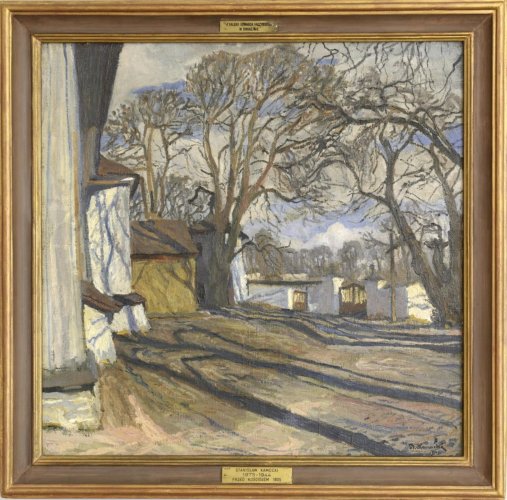Description:
Stanisław Kamocki (1875-1944). His father, an architect, gave him his first drawing lessons, then Kamocki studied at SSP in Kraków, including at L. Wyczółkowski, J. Malczewski and J. Stanisławski. He spent a large part of his education on a scholarship in Paris and travels in Italy. In 1908 he became a professor at the School of Fine Arts for Women, and from 1919 he led the landscape department at the Kraków Academy of Fine Arts. He was considered a successor to J. Stanisławski. He dedicated his artistic life to landscape painting.
Description of the painting:
This painting was created in the early years after Kamocki‘s graduation from the Academy of Fine Arts in Krakow. Despite his young age and lack of experience at the time, this painting is one of his most interesting works. From the beginning, following in the footsteps of his master, Jan Stanislawski, Kamocki painted landscapes, and he remained a landscape painter until the end of his life. He often traveled outside of Krakow for this purpose, painting the surrounding fields and villages. A rural cottage or church often appeared in his landscapes, but the painter was able to combine architecture and landscape into a coherent whole.
The painting “Spring“ depicts a churchyard with a view of the entrance gate. The building and the earth intertwine with each other through the shadows of the trees, and the leafless branches in the background seem to be intertwined with the clouds behind them. The whole composition breathes in the same rhythm. This effect was achieved by Kamocki using delicate simplifications, synthesizing the view, and thanks to the matte, broken colors throughout the composition, without distinguishing any part of the painting. This is a clear influence of Jan Stanisławski, especially strong in the first years of the painter‘s independent creative activity. In later years, Kamocki synthesized his landscapes more and more, used brighter colors and stronger value sets. It is especially interesting to compare the discussed painting with the canvas presented a few years later in the National Museum in Kielce, where you can see exactly the same frame, but already in brighter colors.
The architectural curtain of the left part of the picture is the walls and buildings around the 16th century St. Adalbert‘s Church in Modlnica. The church is wooden, but in the early 20th century it was whitewashed, as can be seen in the painting. Today it is one of the most beautiful and best preserved wooden churches in Poland. According to local legend, St. Adalbert had a stop here on his way to his missions in the north, where he died a martyr‘s death. It is likely that this was the route of St. Adalbert, as Modlnica was the site of a medieval trade route leading to the north.
The architectural curtain of the left part of the picture is the walls and buildings around the 16th century St. Adalbert‘s Church in Modlnica. The church is wooden, but in the early 20th century it was whitewashed, as can be seen in the painting. Today it is one of the most beautiful and best preserved wooden churches in Poland. According to local legend, St. Adalbert had a stop here on his way to his missions in the north, where he died a martyr‘s death. It is likely that this was the route of St. Adalbert, as Modlnica was the site of a medieval trade route leading to the north.


